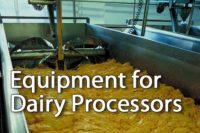Clean machines
A guide to electronic water treatment for dairy food and beverage processors
Electronic water treatment has been used by the food and beverage processing industry to remove fouling from equipment.

A heat exchanger after a Scalewatcher treatment

A heat exchanger before the Scalewatcher treatment

A scaled-up heat exchanger

Limescale in a pipeline

By Jan de Baat Doelman, Scalewatcher North America
Food and beverage processors spend billions of dollars each year in downtime, increased energy bills and the early renewal of capital equipment caused by hard water limescale blocking lines and leaving calcium carbonate deposits on water fed equipment.
Scale and sludge formation are the result of the precipitation of compounds that are no longer soluble under the conditions prevailing at the point of deposition. This typically occurs in the regions of highest temperature and includes a wide range of equipment used within food and beverage production, ranging from heat exchangers to retort cookers, and from steam ovens to reverse osmosis units.
Scale deposits, known as fouling, can cause a number of operational problems such as plugging of equipment, inefficient usage of chemicals, increased utility costs, lost production and downgraded products from increased dirt counts. In addition the incorporation of even undesirable trace particulates can lead to off-flavors or off-colors, reducing shelf life, or even making the product unsaleable.
Scaling deposits are common in flowlines subject to changes of pressure or temperature. Regardless of how hard water effects are achieved, the outcome is the same. Scale formation results in reduced diameter or blocked pipes, reduced heat transfer efficiency, seized pumps, inoperarable valves, misleading meter readings and defective heating elements.
Some of the processes affected by scale formation in the food and beverages industry include:
Retort cookers. Are used extensively within the food manufacturing process. With recycled water reaching temperatures of 284 degrees in the return lines manufacturers experience ongoing problems with calcium build-up.
Steam and combination ovens. Are used extensively in bakeries and regularly scale-up requiring frequent downtime to acid clean. In bakeries, water softens cannot be used as the sodium entering the water supply from the softeners is absorbed by the dough.
Reverse osmosis units. Often have to be chemically cleaned every 80 to 90 hours of operation. The cleaning is determined by the permeate flow rates and pressure differentials across the membranes. The drop in flow rates and increased pressure primarily results from the increasing calcium carbonate fouling on the membrane surface.
Milkstone. When milk is treated in an evaporator for the removal of water, scale in the form of "milkstone" builds up on the inside of the tubes, associated equipment, pumps and pipework. The removal of milkstone is necessary to maintain operating efficiency, with the costs of removal being measured in labor, chemicals, production losses and increased energy costs due to reduced thermal efficiency.
Brinery. Is used to top up the cans with water. Heated by a steam heat exchanger, water on a continuous feed fills each can in turn on a production line. The can is then sealed and taken to a retort for the final cooking process. In hard water areas brineries and pipework regularly block with scale necessitating plant shutdown to descale.
Bottle washers. Calcium of bottes can cause scanners to reject clean bottles. The sidewall scanners on sense a droplet on a bottle and sense it as a mark or shadow.
Chilled water system. In hard water areas, these systems regularly scale up necessitating downtime for descaling.
Heat exchangers. Fouling increases the overall thermal resistance and lowers the overall heat transfer coefficient of heat exchangers as well as impeding fluid flow, accelerating corrosion and increasing pressure drop across the heat exchanger.
Boilers. Steam is raised via a boiler and is then circulated through a pipeline to a tank that heats water for factory use.
EWT is an alternative to chemical and manual descaling
For over 25 years electronic water treatment (EWT) has been used by the food and beverage industry to remove fouling from equipment. To explain the effect of electronic scale removal it is first important to understand the major factors that cause scale. Whilst scale can be a complex of many minerals, calcium carbonate is the most prevalent in industrial processes.
Super saturation. Aqueous solutions can become supersaturated, which means that they contain higher concentrations of dissolved solute than their equilibrium concentration. Such solutions are not stable and are easily triggered into dropping back to saturation level, forcing the dissolved compound to precipitate. Even when a bulk solution is less than fully saturated, scale formation can occur spontaneously due to localized super saturation, at a surface for example.
pH effect on scale formation. The pH of the solution is directly related to its acid content (typically carbonic acid). The higher the acid content, the lower the pH number. The solubility of calcium carbonate is directly affected by the pH of the water. If the pH of the water is decreased, more calcium carbonate solid can be dissolved. Conversely, if the pH of the water rises, it will force calcium carbonate out of solution and hence scale deposits will form.
Temperature effect on scale formation. Gases in general, and specifically carbon dioxide, are less soluble in water at high temperatures. Therefore, as the temperature rises, the dissolved carbon dioxide decreases. This increases the pH of the fluid, reducing the solubility of the calcium carbonate and forcing the mineral to deposit.
Pressure effects on scale formation. Carbon dioxide and gases in general are more soluble under higher pressure. Therefore, as the pressure drops, carbon dioxide gas will be forced out of solution, lowering the carbonic acid concentration. The rise in pH is associated with a drop in calcium carbonate solubility, leading to the formation of mineral scale deposits.
Electronic water conditioning. It is a noninvasive system utilizing a solenoid coil or coils wrapped around the pipework to be treated. A continuously frequency changing signal generator, within a specified range, supplies current to the coils. The pulse shaped current creates an induced electric field, concentric around the axis inside the pipe. As a consequence to this arrangement, any charged particle or ion moving within the field experiences a so-called Lorentz force generated by the interaction between charged particles and magnetic and electric fields.
The treatment influences the initial nucleation, resulting in crystals that do not "stick" together. Untreated water builds up matted structures that continuously grow. This treatment creates idiomorphic, scattered crystals, which do not form matted structures. They have a rotunda shape, which means that they have a larger volume in relation to a smaller surface. This feature makes them sensitive to water currents and they are easily flushed out of the pipeline. As no new scale layers are formed, the sheer force of the water flow will gradually remove existing layers of scale.
The ability to adjust power, frequency and coil configurations of products like the Scalewatcher on site enables performance to be optimized with no downtime and no pipe replacement.
The majority of food and beverage production utilizes water based processes. There is now pressure on these industries to minimize water consumption, reduce energy use as well as the environmental impact of cleaning equipment by using chemicals. Achieving a ‘greener approach’ to calcium carbonate fouling with electronic water conditiong equipment has, in recent years, become a recognized means of dealing with this problem.
Jan de Baat Doelman is the president of Scalewatcher North America, Oxford, Pa.
Looking for a reprint of this article?
From high-res PDFs to custom plaques, order your copy today!








